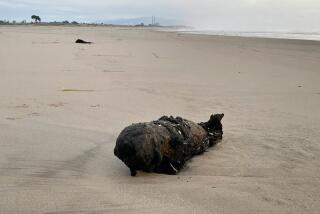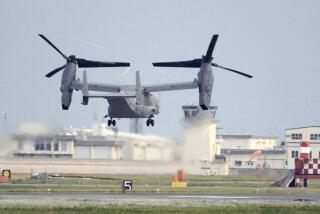H-Bomb Lost at Sea in ’65 Off Okinawa, U.S. Admits
- Share via
WASHINGTON — U.S. officials acknowledged Monday that a Navy warplane carrying a hydrogen bomb rolled off the deck of an aircraft carrier in 1965 and sank in the ocean 70 miles from Okinawa.
The plane, the pilot and the weapon--lost in 16,200 feet of water off the Japanese island--have never been recovered.
The incident, the most serious involving nuclear weapons in the Navy’s history, provides evidence that U.S. warplanes operating off Vietnam were loaded with nuclear bombs and that U.S. warships carried atomic weapons into Japanese ports in violation of Japanese policy, according to two researchers who uncovered the information.
The report Monday provoked outrage in Japan, the only country ever to be attacked with nuclear weapons, where the story was prominently displayed in virtually every newspaper and television news broadcast.
Japanese law bans ships carrying nuclear weapons from sailing in its territorial waters or calling on its ports. It is an open secret, however, that U.S. warships routinely dock in Japan with nuclear weapons aboard. Japanese officials never challenge the Navy, and the United States never confirms or denies the presence of nuclear weapons aboard its ships or aircraft.
“For 24 years, the U.S. Navy has covered up the most politically sensitive accident that has ever taken place,” William M. Arkin of the liberal Institute for Policy Studies said at a Washington press conference Monday.
“The Navy kept the true details of this accident a secret not only because it demonstrates their disregard for the treaty stipulations of foreign governments but because of the questions it raises about nuclear weapons aboard ships in Vietnam,” Arkin said.
A Navy spokesman said Monday that the plane and the bomb are in water too deep to be recovered and that the weapon poses no threat of explosion or release of radioactivity. “The environmental impact is expected to be nil,” Lt. Cmdr. James Kudla, a Navy spokesman, said.
He declined to discuss Arkin’s other charges.
The incident is reported in a forthcoming book on nuclear accidents at sea by Arkin and co-author Joshua Handler of the environmental group Greenpeace, which has been conducting a campaign to rid the world’s seas of nuclear weapons.
The book documents more than 1,200 accidents involving nuclear weapons or nuclear-powered ships, the authors said. A total of 11 nuclear reactors and 48 nuclear weapons--a majority of them Soviet--have been lost at sea and pose significant environmental hazards, they said.
On Dec. 5, 1965, as the aircraft carrier Ticonderoga was steaming from duty off Vietnam toward a port call at Yokosuka, Japan, an A-4E Skyhawk attack jet armed with a hydrogen bomb rolled off an elevator platform and into the sea.
A lifeboat from the carrier and two escort ships searched for the lost pilot for about two hours before abandoning the effort, according to a log kept by officers of the Ticonderoga.
The carrier was 70 miles from the nearest island and about 200 miles east of Okinawa, according to the ship’s records. Arkin released copies of the records obtained from the National Archives.
Brief Statement in ’81
The Navy issued a brief statement in 1981 acknowledging that the jet was carrying a nuclear bomb and stating that the incident occurred in the Pacific “more than 500 miles from land.” No further details were released, and the Navy on Monday offered no elaboration.
Arkin charged that the 1981 statement was deliberately misleading. The ship was not named, nor was it noted that while the accident occurred 500 miles from mainland China, it was less than 100 miles from the populated Okinawa archipelago, which at the time was U.S.-occupied territory. The islands were returned to Japanese control in 1972.
In Okinawa prefecture, a string of islands stretching 570 miles south of Japan’s main islands, citizens expressed anger Monday at the report, Masaji Shinzato, a reporter for the Okinawa Times, told the Associated Press.
“Shock is running through Okinawa. This seems to represent how Okinawa was used freely by the American military in those days,” he said.
The Navy statement also did not note that the ship was headed for Japan after combat duty off Vietnam. Arkin and Handler said they discovered the ship’s deployment schedule and the handwritten record of the accident in the National Archives, which retains the sailing logs of Navy ships.
The researchers said the bomb was a one-megaton B-43 thermonuclear weapon with a yield 70 times greater than the bomb dropped on Hiroshima during World War II. The B-43 is a 12-foot-long free-fall bomb that entered the arsenal in 1959 and is gradually being phased out, they said. It is carried on a variety of Air Force, Navy and Marine Corps attack planes.
Although a few military commanders advocated the use of nuclear weapons against North Vietnam during the Vietnam War, it was never seriously considered, officials have said. But U.S. aircraft, including those based on carriers, for years carried nuclear bombs around the clock on airborne alert. The practice was abandoned in 1968 for cost and safety reasons.
More to Read
Sign up for Essential California
The most important California stories and recommendations in your inbox every morning.
You may occasionally receive promotional content from the Los Angeles Times.













